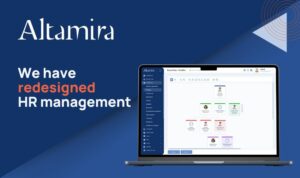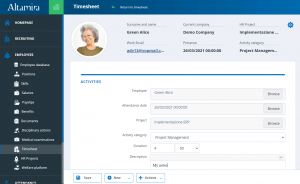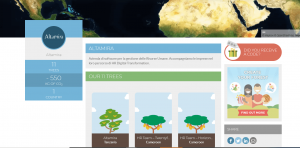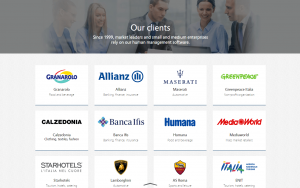Today’s HR professionals, particularly those dealing with the research and selection processes, need to possess numerous competencies that were once unthinkable for this role.
These include skills traditionally linked to marketing and IT that have become crucial to outline and carry out the employer branding strategy, or to optimize existing processes with data analytics.
Besides the unavoidable ATS, modern recruiters are now required to familiarize themselves with a multitude of digital solutions in order to complete their tasks in the most efficient way.
In this article, we present six of these tools, all available in a free version.
Canva

Canva is a cloud-based software that allows users to easily create near-professional graphic projects without the need for complex software such as Illustrator or Photoshop.
Whether you want to create visual content for Instagram, update the cover on the company’s LinkedIn page, or prepare an infographic showcasing the benefits offered to new hires, Canva has you covered.
The considerable number of free templates, along with an intuitive interface, allows users to achieve satisfying results in a matter of minutes. That being said, the assistance of a professional designer is still recommended for bigger and more important projects.
Canva is a good choice for those companies that directly involve recruiters in the employer branding strategy, as it allows them to independently create engaging content to attract potential candidates.
The free version has several limitations but is powerful enough to satisfy most common needs.
TinyPNG

Size can be an issue when it comes to responsive web design. Cumbersome files can’t be sent as e-mail attachments, increase loading time for websites and corporate blogs, and create delays in download for users.
Luckily for us, the web is rich with platforms entirely dedicated to image optimization and capable of quickly compressing files without affecting the overall image quality.
One of our favorites is TinyPNG, not only because of its intuitive interface and free-to-use model (at least for occasional users), but also for its playful and charming animations. After all, who doesn’t love pandas?
Powtoon

Video is undoubtedly the most effective multimedia format right now; compelling, immersive, and engaging, video is the perfect medium for an employer branding campaign.
However, crafting a professional video is a somewhat complex process that requires skills not commonly available to recruiters, not to mention a considerable budget.
Choosing a cloud-based software can be a good solution, as it allows even beginner users to create good-quality videos and presentations using premade editable templates.
Most of these platforms are available for free, albeit with substantial limitations, and can be used to create simple but effective video content.
It goes without saying that the creation of more original content (without the use of premade templates) will require some level of creativity and skills.
One tool we had the opportunity to try is Powtoon, which is particularly suitable for creating explainer videos. Visme, on the other hand, seems more suited to creating video infographics.
Hootsuite

Those who work in social recruiting or wish to develop a strong social media presence cannot do without a social media marketing program such as Hootsuite.
These programs allow users to manage multiple social profiles from a single hub, schedule posts in advance, monitor conversations around specific topics, schedule paid ads, etc.
The free version of Hootsuite allows users to link up to two social accounts and schedule up to 5 posts at a time. It’s an excellent way to keep up with hot topics and trending content, especially through Twitter conversations.
Google Analytics
In today’s world, company’s career sites are crucial for recruitment and employer branding. Consequently, employers need to monitor their performance and the behavior of visitors and potential candidates with dedicate software capable of analyzing user traffic.
Most likely, the IT department and/or the corporate marketing department are already using such tools and can provide segmented access to the HR office. On the other hand, if the career site was created by the ATS provider, the service may not be guaranteed.
Today, the most widely used tool is Google Analytics, which has the unbeatable advantages of being free, well documented, and seamlessly integrated with other useful Google tools, such as Google Ads and the Google Search Console. However, Google Analytics is currently under the investigation of several European data protection authorities for its violation of non-EU data export and even version 4, which anonymizes users’ IP, is not fully compliant.
While waiting for the situation to be resolved, we suggest experimenting with Matomo, a fully compliant software that hosts data locally on the user’s server.
User behavior analytics can provide some crucial metrics related to the career site, such as the drop-off rate for application forms (a high number could suggest the need for a more agile template), employer branding content engagement, most viewed vacancies, etc.
The ATS will then allow recruiters to combine these data with other critical information, such as the source of submitted CVs and of hired candidates.
Mailchimp

If during the application phase you also collect consent for marketing purposes or for the subscription to a newsletter, you have the opportunity to “cultivate” potential candidates over time by keeping them updated on the company’s initiatives and career opportunities.
Among the many software dedicated to collecting and delivering newsletters, one of the most popular solutions is Mailchimp, an intuitive platform with a very generous free plan.
Even in its free version, Mailchimp allows users to easily craft beautiful newsletters, build subscription lists, and provide plenty of online storage for the content companies wish to share.
As with Google Analytics, the position of the European data protection authorities toward non-EU marketing software is still unclear.
Copyright: ©Otto/Adobe Stock




























































































